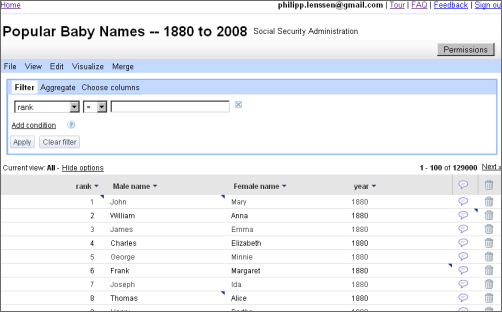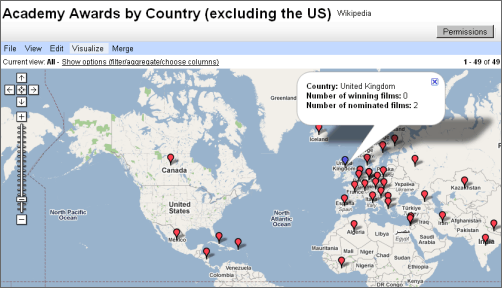Wednesday, June 10, 2009
New From Google: Fusion Tables

The tables overview...

A single table is displayed, 100 rows at a time.

Map visualization of data. (Google Spreadsheets has a related feature via Insert → Gadget → Maps.)
The Google Labs have released a new tool called Fusion Tables. It lets you view, visualize, merge & discuss large tables of data. In the tables gallery right now, there’s data like baby names, or Academy Awards by country.
Somewhat confusingly, this product seems like a set of features that already is, or seemingly could become, integrated in the existing Google Spreadsheets. Creating a new product just to manage more data seems like the opposite of consolidation efforts – merging products into a larger one instead of creating multiple related ones at separate locations. Google’s Marissa Mayer said in 2006 “It is hard for people to remember more than 5 or 10 products from a particular company. If we can take each of the products we have and make them even larger and more meaningful to people, I think there’s a lot of benefit that could be had by both the users, because they don’t have to remember quite as much”.
In the Fusion Tables FAQ, Google addresses the issue of how this product is supposed to be different from Google Spreadsheets:
The goal of Fusion Tables, as with other database systems, is to manage larger amounts of data than spreadsheets typically do. This size difference leads to a focus on a different set of functionalities. For example, Fusion Tables focuses more on bulk operations on the data (filtering, aggregation, merges). These operations are typically not necessary for smaller collections of data stored in spreadsheets. In contrast, spreadsheets preserve complete flexibility in managing data – you can put any value you want in any cell and work carefully to format your spreadsheet to make it look nice. Fusion Tables requires that the data be tabular with column headers and types for each column.
As far as size limits are concerned, Google in their help elsewhere says that each Google Spreadsheet “can be up to 256 columns, 200,000 cells, or 100 sheets – whichever is reached first. There’s no limit on rows.”
[Hat tip to Hebbet and Ionut!]
>> More posts
Advertisement
This site unofficially covers Google™ and more with some rights reserved. Join our forum!
